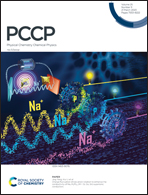InN/XS2 (X = Zr, Hf) vdW heterojunctions: promising Z-scheme systems with high hydrogen evolution activity for photocatalytic water splitting†
Abstract
Z-scheme van der Waals heterojunctions are very attractive photocatalysts attributed to their excellent reduction and oxidation abilities. In this paper, we designed InN/XS2 (X = Zr, Hf) heterojunctions and explored their electronic structure properties, photocatalytic performance, and light absorption systematically using first-principles calculations. We found that the valence-band maximum (VBM) and conduction-band minimum (CBM) of the InN/XS2 (X = Zr, Hf) heterojunctions are contributed by InN and XS2, respectively. Photo-generated carriers transferring along the Z-path can accelerate the recombination of interlayer electron–hole pairs. Therefore, the photogenerated electrons in the CBM of the InN layer can be maintained making the hydrogen evolution reaction occur continuously, while photogenerated holes in the VBM of the Ti2CO2 layer make the oxygen evolution reaction occur continuously. The band edge positions of heterojunctions can straddle the required water redox potentials, while pristine InN and XS2 (X = Zr, Hf) can only be used for photocatalytic hydrogen evolution or oxygen evolution, respectively. Furthermore, the HER barriers can be tuned by transition metal doping. With Cr doping, the hydrogen evolution reaction (HER) barriers decrease to −0.12 for InN/ZrS2 and −0.05 eV for InN/HfS2, very close to the optimal value (0 eV). In addition, the optical absorption coefficient is as high as 105 cm−1 in the visible and ultraviolet regions. Therefore, the InN/XS2 (X = Zr, Hf) heterojunctions are expected to be excellent photocatalysts for water splitting.



 Please wait while we load your content...
Please wait while we load your content...